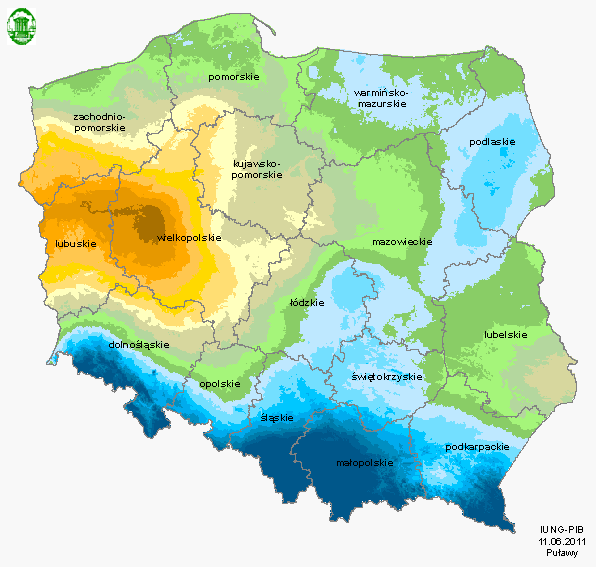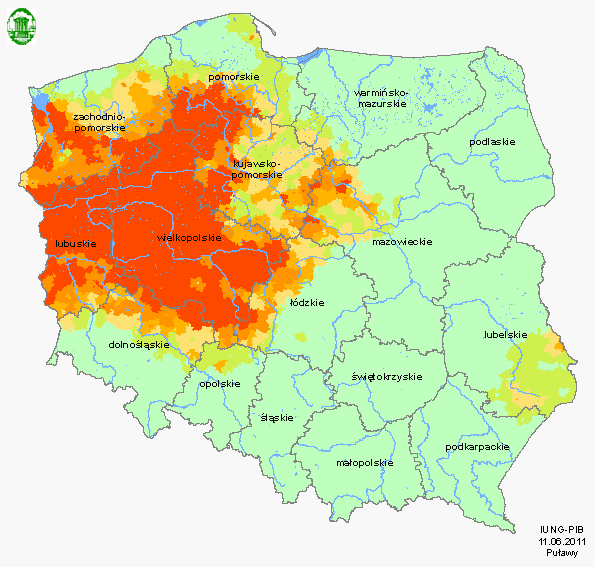ARCHIVES (2011)
Do roku 2016 raport oznaczony numerem 1 był tworzony za okres od 1 kwietnia do 31 maja. Od roku 2017 analizy są wykonywane o dekadę wcześniej czyli 1 raport oznacza okres od 21 marca do 20 maja
Communication report regarding the incidences of drought conditions in Poland
Year: 2011; period: 02 (11.IV - 10.VI)
In the second reporting period, i.e. from 11 April to 10 June 2011, we can find a threat of drought in the area of Poland. The value of climatic water balance (CWB), on the basis of which the risk assessment of drought is calculated in all parts of areas of Poland was negative.
Compared to the first report, in all the localities there was a decline in the value of climatic water balance. The average CWB decline in Poland was 20 mm; this means a further widening of the water deficit for crops.
The threat of drought compared to the situation from 10 days before, has been a considerable increased. The increase of drought risk was calculated for 332 local districts. Currently, drought occurs in 1144 local districts (37.3%), concentrated in 12 voivodeships:
|
Voivodeship |
Number of threatened local districts |
Participation of threatened local districts [%] |
Participation threatened area in the arable land area [%] |
|
wielkopolskie |
316 |
100,0 |
91,0 |
|
lubuskie |
116 |
100,0 |
86,3 |
|
kujawsko-pomorskie |
176 |
98,3 |
39,7 |
|
zachodniopomorskie |
131 |
79,4 |
42,1 |
|
pomorskie |
85 |
60,7 |
18,2 |
|
łódzkie |
79 |
39,1 |
15,7 |
|
dolnośląskie |
76 |
33,9 |
16,3 |
|
lubelskie |
60 |
25,6 |
1,4 |
|
mazowieckie |
75 |
20,6 |
6,9 |
|
opolskie |
14 |
13,6 |
0,9 |
|
warmińsko-mazurskie |
13 |
8,7 |
1,4 |
|
podkarpackie |
3 |
1,6 |
0,1 |
In a previous report, ten voivodeships were threatened by drought. All the voivodeships mentioned above increased their agricultural drought risk area. Drought in Poland occurs at 21.7% of the arable area (10 days ago appeared on the surface of 15.8%).
Drought occurs among the shrubs, winter and spring cereals, strawberries and fruit trees grown on soils of all categories:
• Category I (very light), a group of granulometric: sand
• category II (light), a group of granulometric: loamy sand.
• Category III (medium-heavy), a group of granulometric: sandy loam, silt
• Category IV (heavy), granulometric group: sandy clay loam, loam, clay loam, silt loam, clay
The lowest values of CWB, similar like ten days ago, were found in the Wielkopolskie and Lubuskie voivodeships, except that now these values are much lower. In almost the whole area of both voivodeships, the CWB values ranged from -169 to -229 mm. Drought has increased its reach, especially in the north (covering more areas and the voivodeships of Zachodniopomorskie and Pomorskie) and in an easterly direction.
A large water deficit occurs in the south-eastern part of the Lubelskie voivodeship, increased by a further 10 mm with a value of -159 mm.
Only in the south of the country in the voivodeships of Śląskie, Małopolska and Podkarpackie, the CWB values were greater than -50 mm.
April of this year was very warm. The highest temperature occurred in the Wielkopolsko-Kujawskim Lakelands, reaching 11-12oC and the Lubuskie Lake District, even more than 12oC, in other areas of the country the air temperature was also high from 9 to 11°C. Only in the eastern part of the Embankment of Zachodniopomorskie near Suwalki, the temperature was slightly lower and amounted to 7-9oC, but it was higher than the average long-term value (from three decades from 1971 to 2000) from 1 to 2°C. In the eastern part of the Poland, the temperature in April was higher than the average long by 2-3°C, in the western part of 3-4oC.
This year, April in terms of its precipitation was very irregular. Very low rainfall, less than 30 mm occurred in western Poland, which accounted for 50% below the standard of many years. However, in the north-western and western parts of the country, the rainfall ranged from 10 to 20 mm and even below 10 mm (Wielkopolska), which accounted for approximately 20% of the norm for this region. In the east and south of the country, the rainfall was higher, at 40-60 mm (about 100% of normal). The highest rainfall, over 100 mm, occurred in Pogórze Śląskie, Beskid Śląski and Beskid Żywiecki, reaching 150% - 160% of the norm.
The air temperature in May was very diverse. Earlier in the month, almost in the whole of the country ground frosts occurred (May 2-6), and were particularly acute in Wielkopolska and Kujawy (the temperature dropped even to -7oC). The other half, especially the last ten days of the month was very warm. The highest temperature occurred (as in April), in the Lubuskie Lake District and the Wielkopolskie (14-15oC), and the lowest was in the Pobrzeżu Gdanskim (11-12oC), in the rest of Poland (12-14oC).
In May, just as in April, the lowest rainfall occurred in Wielkopolska and Kujawy (less than 30 mm), which accounted for 60% of long-term standard. Slightly larger but lower rainfall occurred in the eastern part of the Pobrzeże Zachodniopomorskie and in the southeast of Lubelskie (30-40 mm, 60-70% of norm). The highest rainfall, as in April, occurred in Pogórze Śląskie, Beskid Śląski and Beskid Żywiecki (80-120 mm, 100% of norm). In the remaining area of Poland, the rainfall ranged from 40 to 80 mm.
The first ten days of June were exceptionally warm. The deterioration of moisture conditions occurred throughout Poland due to high air temperatures, especially in the eastern part of the country. The highest temperatures were in the Lublin area, more than 21°C. It was also very warm in Wielkopolska - over 20oC. Only on the coast it was cooler 15-17oC. Although the rainfall over a wide territory of the country were relatively high, in some places even very high (over 50 mm), as in central Poland (eastern part of Wielkopolskie and Kujawsko-Pomorskie and the western parts of Łódzkie voivodeship) and in the Koszalin Coastland and Gdansk, it did not make any improvement to the condition of crops, on the contrary the situation has continued, with a significant deterioration
Reports
- Report 13 (1.VIII - 30.IX)
- Report 12 (21.VII - 20.IX)
- Report 11 (11.VII - 10.IX)
- Report 10 (1.VII - 31.VIII)
- Report 09 (21.VI - 20.VIII)
- Report 08 (11.VI - 10.VIII)
- Report 07 (1.VI - 31.VII)
- Report 06 (21.V - 20.VII)
- Report 05 (11.V - 10.VII) +
- Report 04 (1.V - 30.VI) +
- Report 03 (21.IV - 20.VI) +
- Report 02 (11.IV - 10.VI) +
- Report 01 (1.IV - 31.V) +





